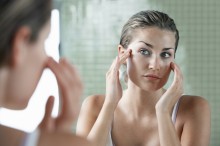No More Sitting; Standing Desks are the answer
- Published: Friday, December 14th 2018
- in Living Well

Stand up. Don’t slouch. Computers are killing our backs. Sitting is as bad for our health as smoking and obesity. Standing desks are a popular solution for health risks associated with our sedentary work lives. But are they a magic bullet for back pain, poor posture and too much weight? We fact checked the benefits to discover the truth about standing desks.
Fact Check: Sitting is Bad for Our Health
According to the prestigious Mayo Health Clinic[1], the answer is yes. If you sit for more than eight hours a day, with no physical activity, you have a risk of dying similar to the risks posed by obesity and smoking. However, there is good news: the Mayo Clinic also reports 60 to 75 minutes of moderately intense physical activity a day could counter the effects of too much sitting. While more studies are needed, the experts at Mayo conclude that less sitting and more moving around contribute to better health.
Fact Check: Standing Helps You Lose Weight
Harvard Health Publishing[2] reports there are common misconceptions about how standing desks impact weight gain or loss. Researchers published a study in the Journal of Physical Activity and Health measuring how many calories subjects burned while doing activities like computer work, standing or walking on a treadmill. Study subjects who were sitting burned 80 calories/hour and those who were standing, about 88 calories/hour. No surprise: walking burned 210 calories/hour.
However, Harvard Health notes that other studies show that after a meal, blood sugar levels return to normal faster if you spend more time standing. Plus, shoulder and back pain may be reduced. Harvard also reminds us that there are other ways to move more at work, such as open floor plans, sitting on inflatable exercise balls instead of chairs and treadmill desks.
Fact Check: Standing Desks Have No Side Effects
Harvard Health confirms that a standing desk can cause some side effects, such as back, leg or foot pain. If you’re transitioning from sitting at your computer to a standing desk, take it slow. Try starting with 30 to 60 minutes day and gradually work up to a half-day.
Fact Check: Standing Desks Make Us Happy
We had to check out this claim because it seemed too good to be true. It turns out that a study[3] showed people who used standing desks reported less stress and fatigue than those who remained seated the entire work day. Plus, nearly 90% said they had more energy.
The Simple Truth
There is research showing that standing desks have real benefits. We recommend adding more movement and stretching to your workday in general. And if you’re interested in a standing desk, try placing your laptop or keyboard on a stack of books to see if you enjoy working in a standing position. Moreover, before you make a decision, do your homework and compare the many options that are on the market.
Tired muscles? Treat yourself to a massage. You deserve it!
[1] MayoClinic.org, “What are the risks of sitting too much?” Edward R. Laskowski, M.D.,
[2] Harvard Health Publishing, “The truth behind standing desks,” Robert H. Shmerling, MD, September 2016
[3] HealthLine.com, “7 benefits of a Standing Desk,” Joe Leech, MS, June 2017



